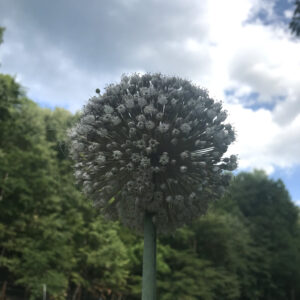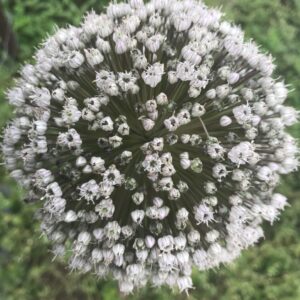- Like
- Digg
- Del
- Tumblr
- VKontakte
- Buffer
- Love This
- Odnoklassniki
- Meneame
- Blogger
- Amazon
- Yahoo Mail
- Gmail
- AOL
- Newsvine
- HackerNews
- Evernote
- MySpace
- Mail.ru
- Viadeo
- Line
- Comments
- Yummly
- SMS
- Viber
- Telegram
- Subscribe
- Skype
- Facebook Messenger
- Kakao
- LiveJournal
- Yammer
- Edgar
- Fintel
- Mix
- Instapaper
- Copy Link
A version of this column first ran in the Roane County (WV) Reporter and Times Record. Support local journalism! Subscribe to your local newspaper. This is one of a series of blogs for new gardeners. Read the rest: Part 1. Part 2. Part 3. Part 4. Part 5. Part 6. Part 7. Part 8. Part 9. Part 10. Part 11. Part 12. Part 13. Part 14.
 Alliums are members of the onion family, including onions, garlic, leeks, elephant garlic…and some perennial onions like potato onions, shallots and Egyptian Walking onions which I won’t discuss as I have not successfully grown them.
Alliums are members of the onion family, including onions, garlic, leeks, elephant garlic…and some perennial onions like potato onions, shallots and Egyptian Walking onions which I won’t discuss as I have not successfully grown them.
Garlic and elephant garlic—which is actually a leek but looks and works like a giant garlic—are planted in the fall, typically October. Garlic comes in soft-neck and hardneck varieties. The softneck ones are said to keep longer and can be braided, but I have had better luck with the hardneck ones (which are hardier, but both are fine here). The hardneck ones send up scapes, elegantly curling seed-tops—you must clip these off to get the plant’s energy to go into producing big bulbs. The bulbs will be ready to harvest about three weeks later.
I generally plant garlic about six inches apart in rows the same distance. They will put up green tops, which may die back in harsh winter weather but will return in early spring. They need to be weeded, usually twice, but need little else till it’s time to pull them around the end of June. Then they should be left in a dry place until the tops are all dead, after which you can clip off the roots and tops, rub off any loose, dirty skins, and put them in storage in a cool dry place.
I used to sneer at elephant garlic because I love “real” garlic and elephant garlic is so mild flavored. But if I think of it as a leek, I appreciate this plant—because I do like and grow leeks but find them more difficult. Leeks are planted from seed very early—I plant them in mid-February. They are very slow growing, so they need that early start. Fortunately, they are very hardy and can be planted out in March if you need more room in your seed starting space. But they look like blades of grass for a long time. They need good rich soil and plenty of moisture, so I plant them next to celery which needs the same pampering and also is started early because it takes so long to achieve a decent size. It should not be set out so early, though it can survive a mild frost. The leeks finally get a reasonable size—say an inch in diameter—in July. Unfortunately for me they rot at the base in August so I have had no chance to see which varieties are hardy enough to survive fall and perhaps winter.
Onions are pretty hardy, too—I always get a few volunteers in the spring from bulbs I missed in the previous year’s harvest. I plant them from sets in March. Once I tried planting them from seed, but found them as slow as leeks—so I figured I could grow them into sets one year, and then get onions the next. I’d rather just buy the sets. I get mostly the yellow or Spanish onions but some red ones too. The white ones don’t keep as well. In choosing sets, you want to avoid the large ones, those over three-quarters of an inch in diameter, as these are likely to flower, split, and rot in storage. You also want to avoid the smallest because, just as you suspect, they will produce little, piddly onions. And of course you want to avoid moldy ones. Onions aren’t picky about soil but they need to be kept free of weeds and they need plenty of water.
Since onions and garlic will come out about the beginning of July, you can plan an arrangement in which some other plant takes over the space they vacate. Leaving an empty patch in the middle of an onion bed for winter squash or melons is one possibility. Planting in a grid pattern, and putting pepper or tomato or sweet potato transplants into the gaps is another. When you pull the onions or garlic, weed the space, mulch it and allow the later plants to take over.
Because we eat a lot of onions and garlic, my house is full of alliums lying about this time of year. We have tried a method of reducing this, hanging a big panel of two-inch mesh poultry netting from the ceiling and poking garlic through the holes, a few inches apart. They seem to be drying faster, as well as taking up less room, so this is a success.
When the onions are dry, I snip off the roots and braid the tops, starting with three big ones. I then tie off the ends with string, and hang the onions from nails in my rafters. I’ve had onions last till March this way, though I do have to cull through my onions and garlic monthly to remove ones starting to rot.













